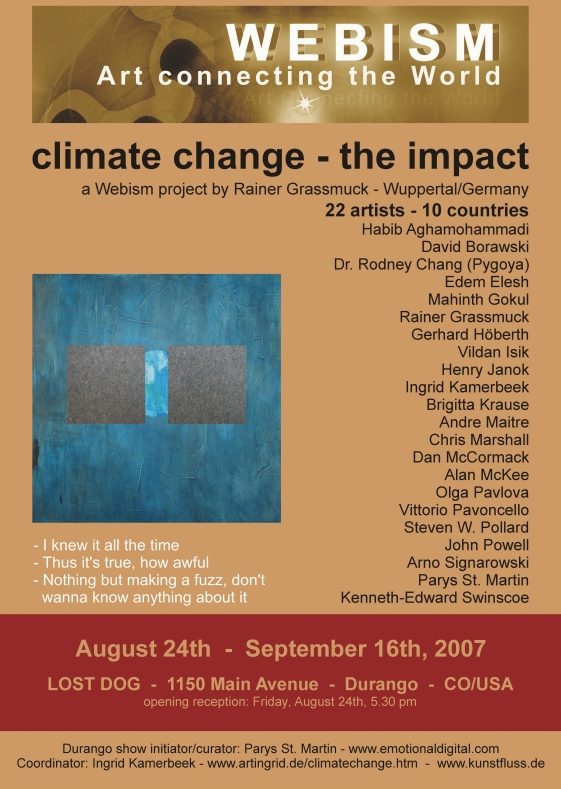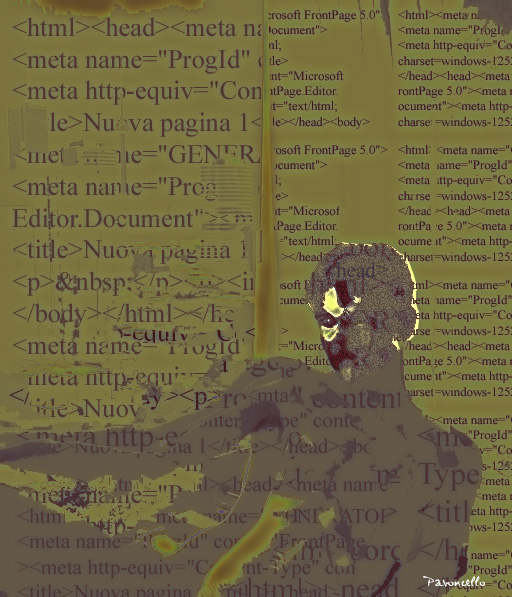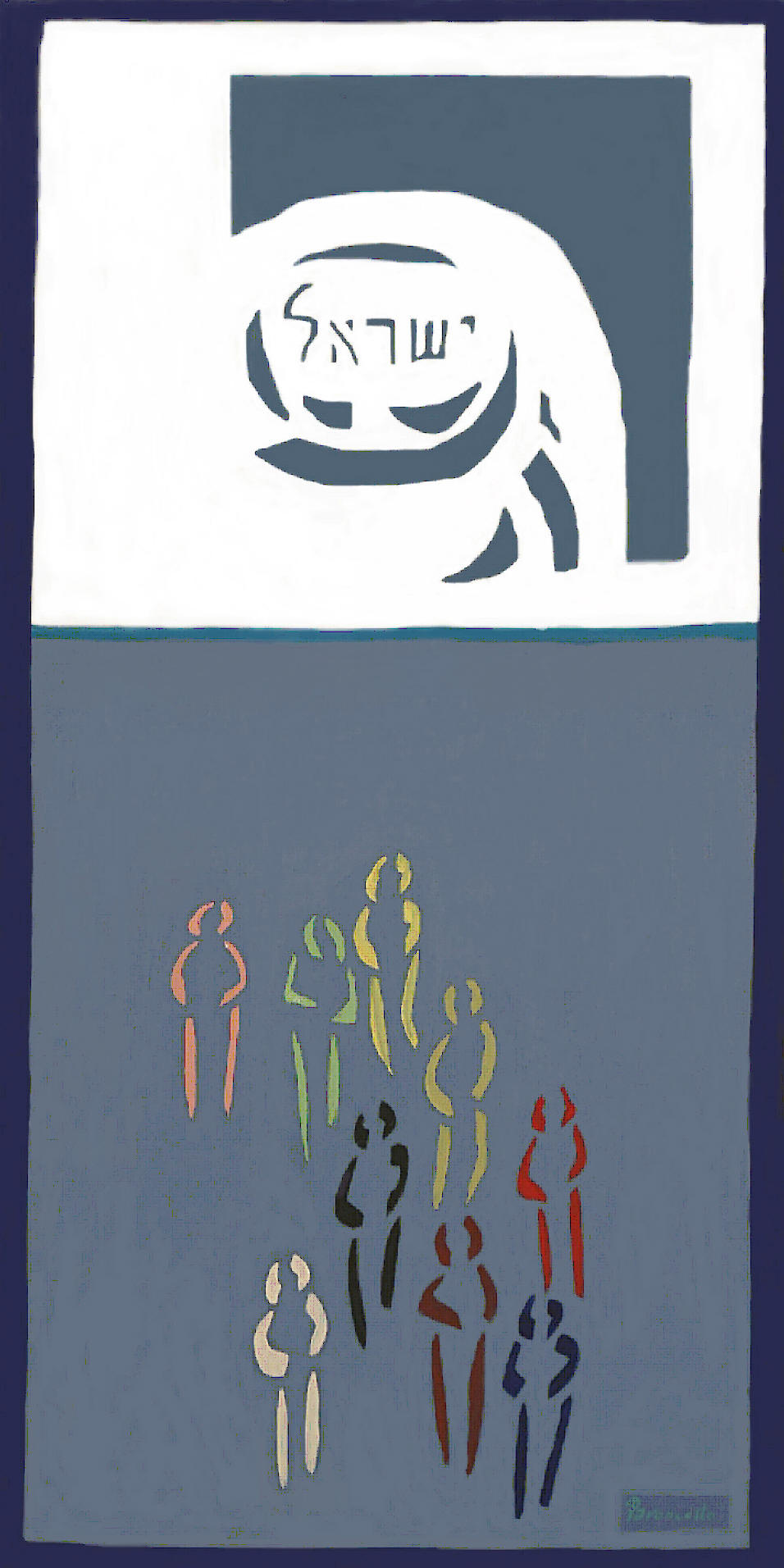 Climate
Change - the impact real life show
Climate
Change - the impact real life show THE DURANGO HERALD
Artful view of climate change
August 21, 2007
Herald Staff Report
Durango artist Parys St. Martin is curating and presenting an international digital-art exhibition called "Climate Change - The Impact."
If you go "Climate Change - The Impact" digital-art exhibit will open
Friday and continue until Sept. 16 at the Lost Dog Bar & Lounge,1150 Main
Ave. An opening reception will be held at 5:30 p.m. Friday.
To view the original show online, visit www.kunstfluss.de/index41.htm.
The show started this year as an online project in Wuppertal, Germany, by
Rainer Grassmuck, who is a member of the international Webist group.
The exhibit in Durango is the first physical presentation of the works,
which includes pieces by 22 artists from 11 countries.
"The latest news regarding climate change splits up humanity to three points
of view," Grassmuck said. "'I knew it all the time.' 'It's true, how awful.'
'Nothing but making a fuss, don't wanna know anything about it.'"
All statements in respect to the future of the climate and influences on our
lives are based upon facts that the participants feel are obvious.
Artists participating in the show come from nations including Iran, Germany,
Singapore, Turkey, Switzerland, Russia and Australia as well as the United
States.
artists:
HabibAghamohammadl, David Borawski, Dr. Rodney Chang (Pygoya), Edem Elesh,
Mahintb Gokul, Rainer Grassmuck, Gerhard Hoberth
Villan Isik, Henry Janok, Ingrid Kamerbeek, Brigida Krause, Andre Maitre,
Chris Marshall, Dan McCOrmack, Alan Mckee, Olga Pavlova
Vittorio Pavoncello, Steven W. Pollard, Jahn Powell, Arno Signarowski, Parys
St. Martin, Kenneth Edward Swinscoe
 Virtualizations Interview to Vittorio Pavoncello by Giovanna Pipari I wanted to meet Vittorio Pavoncello to ask him what the “Virtualizations” are and for what reasons they represent a new artistic expression, not existing so far in the artistic world but that seems to be a new way towards the concept of fusion among genders that probably influences not only the social universe but also the artistic sphere. Q. You are working on a new artistic expression you recently conceived the “Virtualizations”. What kind of work are they and how did you get the idea? A. The idea of the “Virtualizations” came while I was projecting a costume for my next theatre show “A virtual woman”. The question I had in my mind was: how can a costume for a virtual body be? At the end, I found a solution that as it often comes in all the researches, goes far behind what you were looking for because I realized that it wasn’t only a sketch for a costume that I was realizing but a new creation was born: that of “Virtualizations”. Q. Can you explain a little bit more? A. The starting point, drawing by computer was a photo of the actress that I first transformed and of which I searched then the translation in html language. Applying this language, writing it on the actress’ body and dress I had the strong sensation of continuing and modifying the way of the body art, making it newer. Those words in html, impressed over the body, on the skin, were a modality of body art, but they were also something else: tattoos, paintings, etc. With different implications they made me think of Piero Manzoni who signed the audience’s bodies, other images came to my mind: those of cat shows with clothes painted on the bodies, or bodies entirely painted like a branch of contemporary art does. But the Virtualizations, not like some experiences of the body art, gave back to the body and gave it a virtuality and a an abstraction inherent in the phisicity but that remain invisible ant that go far behind of the body art. I had the impression of pulling out the technologic soul of our lives! A Virtualization gives the virtualized body the image like a mask but it’s the mask of the own oneself: because that html language, painted on the body, is the translation on the proper image in a computer language. Q. Therefore, does every image have its own univocal language that cannot belong to any other image? A. Yes, hypothetically. Even better than an image, the aim would be to have a model (real or in a picture) for every image, to whom its own and univocal html code is applied. A Virtualization for example almost works a cloth to be dressed or a change of skin, and like a paradox it is like to wear his own skin or a dress painted on our image. Q. And where do you get the image of the model to be virtualized from? A. So far they are images I possess. But they can be even more personalized, for example, in these first experiments published on the blog of the virtual woman, (http://unadonnavirtuale.leonardo.it) in html language taken from an image chosen by chance and I enjoyed myself to put some fictitious names. But maybe someday a certain Mr Smith will be able to have a portrait of his own with his name. And all this coming from the code that his own body or face creates transferred on a image on the computer. Q. Some famous people also could be virtualized by you? A. Yes, there can be some famous people virtualized. Even if I have some objections on working with nowadays famous people. And here I have to make a remark to Andy Warhol, to be worth of and of easiness, even if he wanted to work on the mythic icon. I’m talking about the series of paintings “Do it yourself”, the question could be that Warhol put in some paintings put some numbers like if they were jigsaws to fill, and this was very interesting. The less enjoyable aspect is that take a paintings of some famous people, gives to some, maybe too many, the idea of being artists only because... personally I can consider that someway a famous person would like to be virtualized by me this can happen, but I think that it is not a condition or a passport to be virtualized. Q. Is it important for you in this work the influence of hypothetic art that I know you have been interested in for a long time? A. Hypothetic art is central. And on it I’m thinking and creating I have been creating for long time. But like some thoughts and theories sometimes need technologies to be emphasised or to be shown or to be more powerful, this time technology express perfectly an aesthetic production. There is a sentence in the blog that says: ”Virtual is like a tattoo that science creates and art make appear”. D. You named the need of technologies, new technologies. Do you think that art, like human society needs to follow the step and melt with them otherwise it risks isolation? R. Contemporary art is already strongly inwrought by new technologies, you can often see exhibition made by videos, multimediality, olographies. Sinestesy between art and technology has been acting for a long time. What a Virtualization could imply is to go back to paint, well, for example, a urban landscape. Q. Are you saying that even a urban landscape, or not urban, can be virtualized? A. Exactly. Why not? A landscape or architecture could be with no doubt virtualized, and for this reason virtualizations open a wide field on different ways and researches. But there is also another aspect that I’m interested in, regarding galleries or spaces with events, for virtualizing models directly on stage. And then, leave these virtualized bodies to act in the space. Q. I was wondering, listening to your explanations, could an exhibition of virtualized works be created? A. Surely. And the procedure would be to have the works already printed and exposed while some others will be made live. Q. To interpret this new way of expressing art there is hidden a female figure (“A virtual woman”). Could there have been a “Virtual man” behind such a multimedia project? A. Yes, but women body, like for iconographic tradition, has become the body that still maintains that mystery of “the body”. But in the virtualizations that I’m making there are also some male figures, like there could be landscapes, or still nature images, or a pot of flowers, of a Canaletto view. Virtualizations by Vittorio Pavoncello can be seen so far exclusively on the blog http://unadonnavirtuale.leonardo.it or on his website www.vittoriopavoncello.net The blog “A virtual woman” has been created to precede the theatre show “A virtual woman” studied for a place like the stage historically known for its virtual implications inside its nature. The show is written by Vittorio Pavoncello and the actress on stage will be Raffaella Ponzo. Vittorio Pavoncello One of his latest and most important exhibition was “Il popolo del sogno” (The people of dream)am in 2004 at Complesso del Vittoriano (Roma) www.etica.name , Sala Margana (Roma) and Studio Tommaseo (Trieste). Press office: Giovanna Pipari www.giovannapipari.net |

LA REGINA E L’ALCHIMISTA di Anna Foa e Vittorio Pavoncello
Domenica 20 Agosto alle ore 20
l’Associazione Culturale OZU
(Largo Moricone, 1 – 02033
Monteleone Sabino, Rieti) presenta “Lettura
d’autore: LA REGINA E L’ALCHIMISTA
di e con Anna Foa
e Vittorio Pavoncello.
I due autori leggeranno il loro testo accompagnati dal pianoforte di Nicolas VinderWood e dall’arpa di Nicole Marinucci in questa suggestiva area derivata da una fabbrica abbandonata nell’Alta Sabina che si è trasformata in un laboratorio di scambi culturali e officina dell’arte.
Ufficio Stampa:Giovanna Pipari tel/fax 06-6380845 cell 349 6337613 mail giopipari@hotmail.com http://webalice.it/giopipari

“25 WORDS of the TORAH find their HOME”
The Hebraic almshouse and the Association E.T.I.C.A. present:
Vittorio Pavoncello - “WORDS AND THINGS FROM GENESIS”
25 paintings from Genesis
and the performance “SHYLOCK’ s VIOLIN” by Vittorio Pavoncello
On the occasion of the 7th European Day of Hebraic Culture having the theme of “Hebraic Itineraries”, E.T.I.C.A. Association presents the exhibition of 25 paintings “Words and things” from Genesis by Vittorio Pavoncello wanted and donated to the Hebraic almshouse of Rome (CRER Via Portuense, 216 – 00149 Rome) to adobe its walls with colour and Hebraic culture.
E.T.I.C.A, furthermore, presents in preview the same day at 8 pm the show for voice and violin “Shylock’s violin” written by Vittorio Pavoncello in which, with a lecture in a contemporary key of Shakespeare’s opera “The Venice merchant” and extrapolating the figure of Shylock through a journey in time, all the abuses of power, prosecutions and prejudices in the past and in the present against the Jewish people are displayed, giving an original performance to the theatrical figure of Shylock. The voice is Daniele di Porto’s and the violin is played by Marco Valabrega.
Ufficio Stampa:Giovanna Pipari tel/fax +39 06-6380845 - cell 349 6337613 - mail giopipari@hotmail.com www.giovannapipari.net